Business Valuation Assignment PDF
VerifiedAdded on 2021/08/16
|20
|2634
|124
AI Summary
Contribute Materials
Your contribution can guide someone’s learning journey. Share your
documents today.
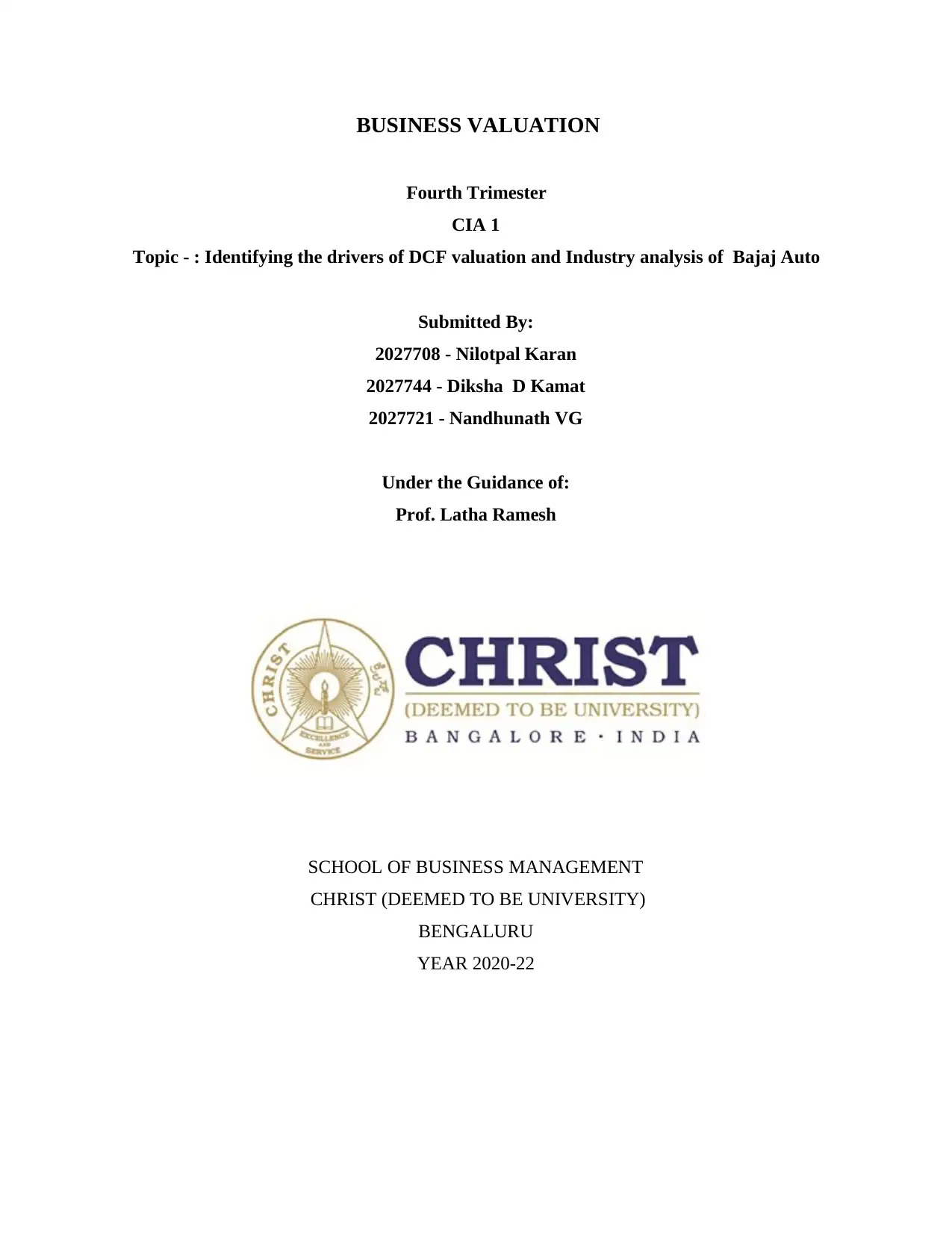
BUSINESS VALUATION
Fourth Trimester
CIA 1
Topic - : Identifying the drivers of DCF valuation and Industry analysis of Bajaj Auto
Submitted By:
2027708 - Nilotpal Karan
2027744 - Diksha D Kamat
2027721 - Nandhunath VG
Under the Guidance of:
Prof. Latha Ramesh
SCHOOL OF BUSINESS MANAGEMENT
CHRIST (DEEMED TO BE UNIVERSITY)
BENGALURU
YEAR 2020-22
Fourth Trimester
CIA 1
Topic - : Identifying the drivers of DCF valuation and Industry analysis of Bajaj Auto
Submitted By:
2027708 - Nilotpal Karan
2027744 - Diksha D Kamat
2027721 - Nandhunath VG
Under the Guidance of:
Prof. Latha Ramesh
SCHOOL OF BUSINESS MANAGEMENT
CHRIST (DEEMED TO BE UNIVERSITY)
BENGALURU
YEAR 2020-22
Secure Best Marks with AI Grader
Need help grading? Try our AI Grader for instant feedback on your assignments.
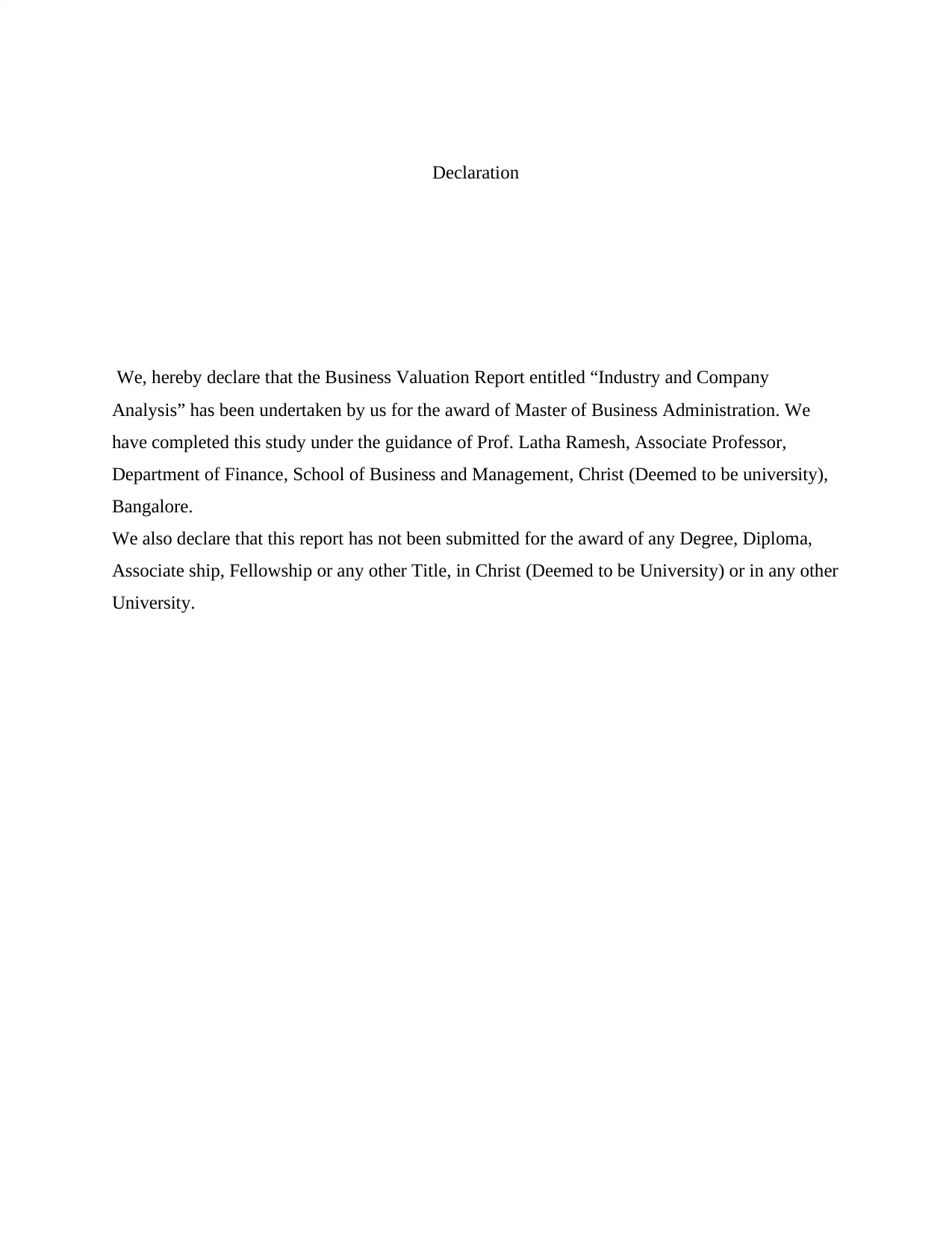
Declaration
We, hereby declare that the Business Valuation Report entitled “Industry and Company
Analysis” has been undertaken by us for the award of Master of Business Administration. We
have completed this study under the guidance of Prof. Latha Ramesh, Associate Professor,
Department of Finance, School of Business and Management, Christ (Deemed to be university),
Bangalore.
We also declare that this report has not been submitted for the award of any Degree, Diploma,
Associate ship, Fellowship or any other Title, in Christ (Deemed to be University) or in any other
University.
We, hereby declare that the Business Valuation Report entitled “Industry and Company
Analysis” has been undertaken by us for the award of Master of Business Administration. We
have completed this study under the guidance of Prof. Latha Ramesh, Associate Professor,
Department of Finance, School of Business and Management, Christ (Deemed to be university),
Bangalore.
We also declare that this report has not been submitted for the award of any Degree, Diploma,
Associate ship, Fellowship or any other Title, in Christ (Deemed to be University) or in any other
University.
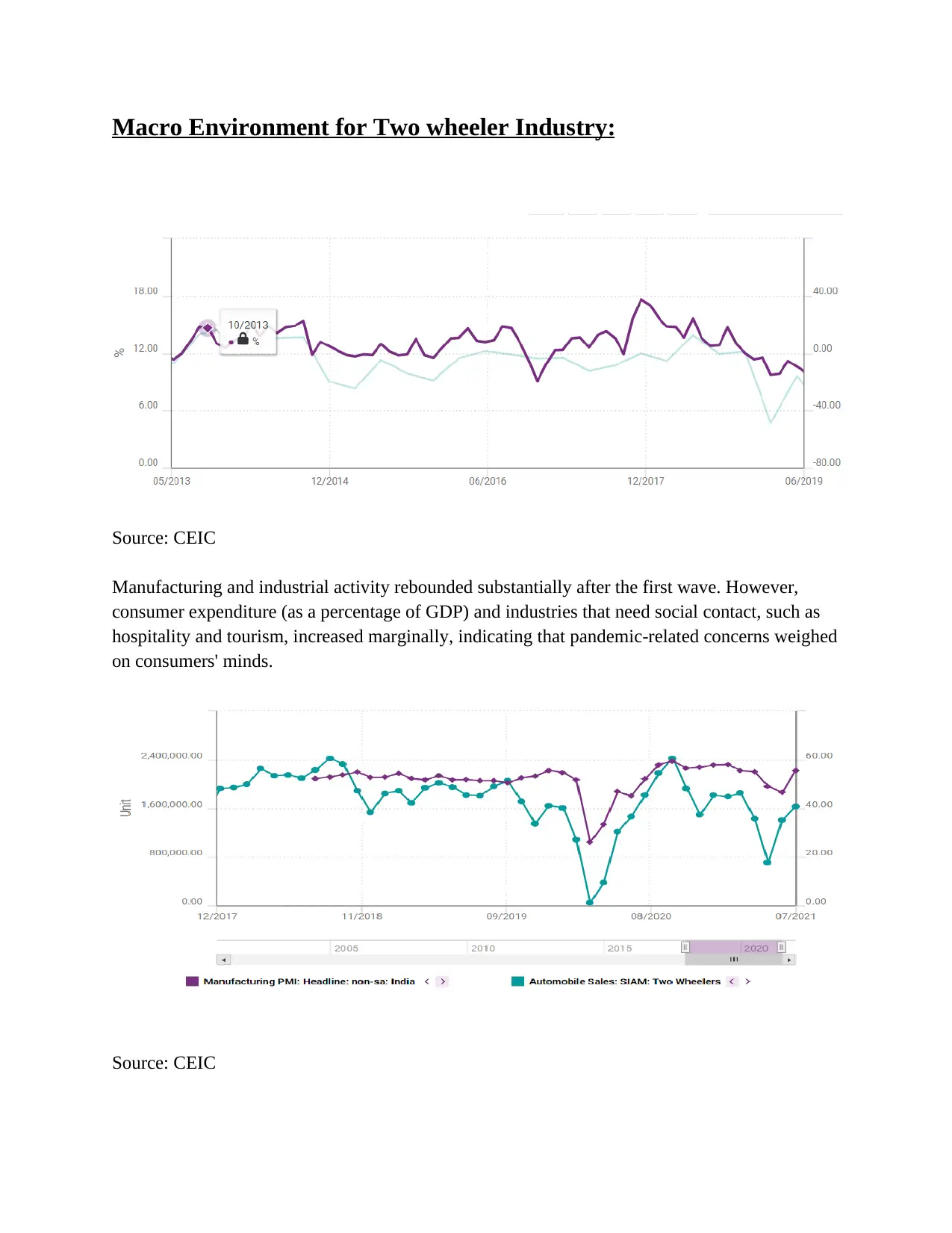
Macro Environment for Two wheeler Industry:
Source: CEIC
Manufacturing and industrial activity rebounded substantially after the first wave. However,
consumer expenditure (as a percentage of GDP) and industries that need social contact, such as
hospitality and tourism, increased marginally, indicating that pandemic-related concerns weighed
on consumers' minds.
Source: CEIC
Source: CEIC
Manufacturing and industrial activity rebounded substantially after the first wave. However,
consumer expenditure (as a percentage of GDP) and industries that need social contact, such as
hospitality and tourism, increased marginally, indicating that pandemic-related concerns weighed
on consumers' minds.
Source: CEIC
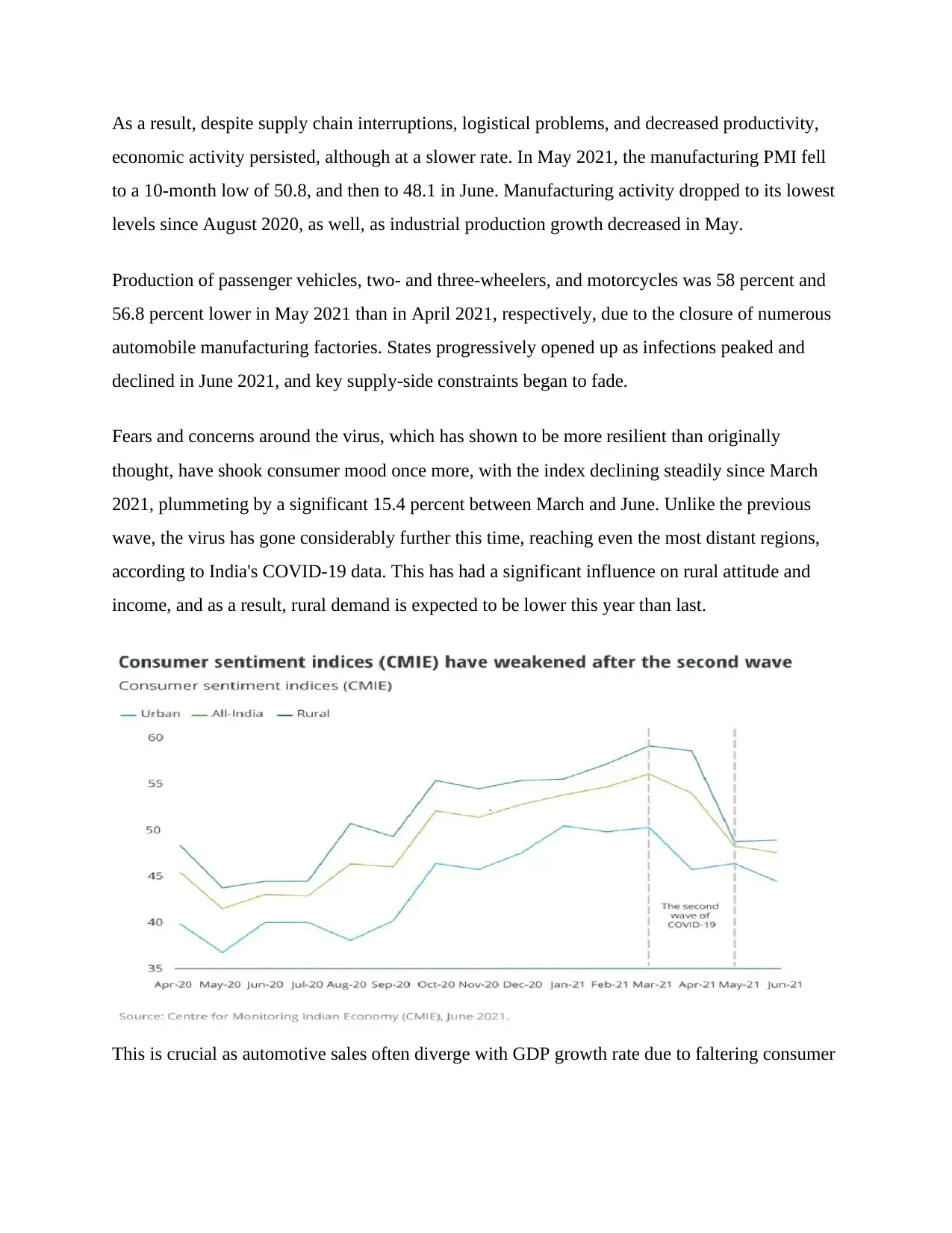
As a result, despite supply chain interruptions, logistical problems, and decreased productivity,
economic activity persisted, although at a slower rate. In May 2021, the manufacturing PMI fell
to a 10-month low of 50.8, and then to 48.1 in June. Manufacturing activity dropped to its lowest
levels since August 2020, as well, as industrial production growth decreased in May.
Production of passenger vehicles, two- and three-wheelers, and motorcycles was 58 percent and
56.8 percent lower in May 2021 than in April 2021, respectively, due to the closure of numerous
automobile manufacturing factories. States progressively opened up as infections peaked and
declined in June 2021, and key supply-side constraints began to fade.
Fears and concerns around the virus, which has shown to be more resilient than originally
thought, have shook consumer mood once more, with the index declining steadily since March
2021, plummeting by a significant 15.4 percent between March and June. Unlike the previous
wave, the virus has gone considerably further this time, reaching even the most distant regions,
according to India's COVID-19 data. This has had a significant influence on rural attitude and
income, and as a result, rural demand is expected to be lower this year than last.
This is crucial as automotive sales often diverge with GDP growth rate due to faltering consumer
economic activity persisted, although at a slower rate. In May 2021, the manufacturing PMI fell
to a 10-month low of 50.8, and then to 48.1 in June. Manufacturing activity dropped to its lowest
levels since August 2020, as well, as industrial production growth decreased in May.
Production of passenger vehicles, two- and three-wheelers, and motorcycles was 58 percent and
56.8 percent lower in May 2021 than in April 2021, respectively, due to the closure of numerous
automobile manufacturing factories. States progressively opened up as infections peaked and
declined in June 2021, and key supply-side constraints began to fade.
Fears and concerns around the virus, which has shown to be more resilient than originally
thought, have shook consumer mood once more, with the index declining steadily since March
2021, plummeting by a significant 15.4 percent between March and June. Unlike the previous
wave, the virus has gone considerably further this time, reaching even the most distant regions,
according to India's COVID-19 data. This has had a significant influence on rural attitude and
income, and as a result, rural demand is expected to be lower this year than last.
This is crucial as automotive sales often diverge with GDP growth rate due to faltering consumer
Secure Best Marks with AI Grader
Need help grading? Try our AI Grader for instant feedback on your assignments.
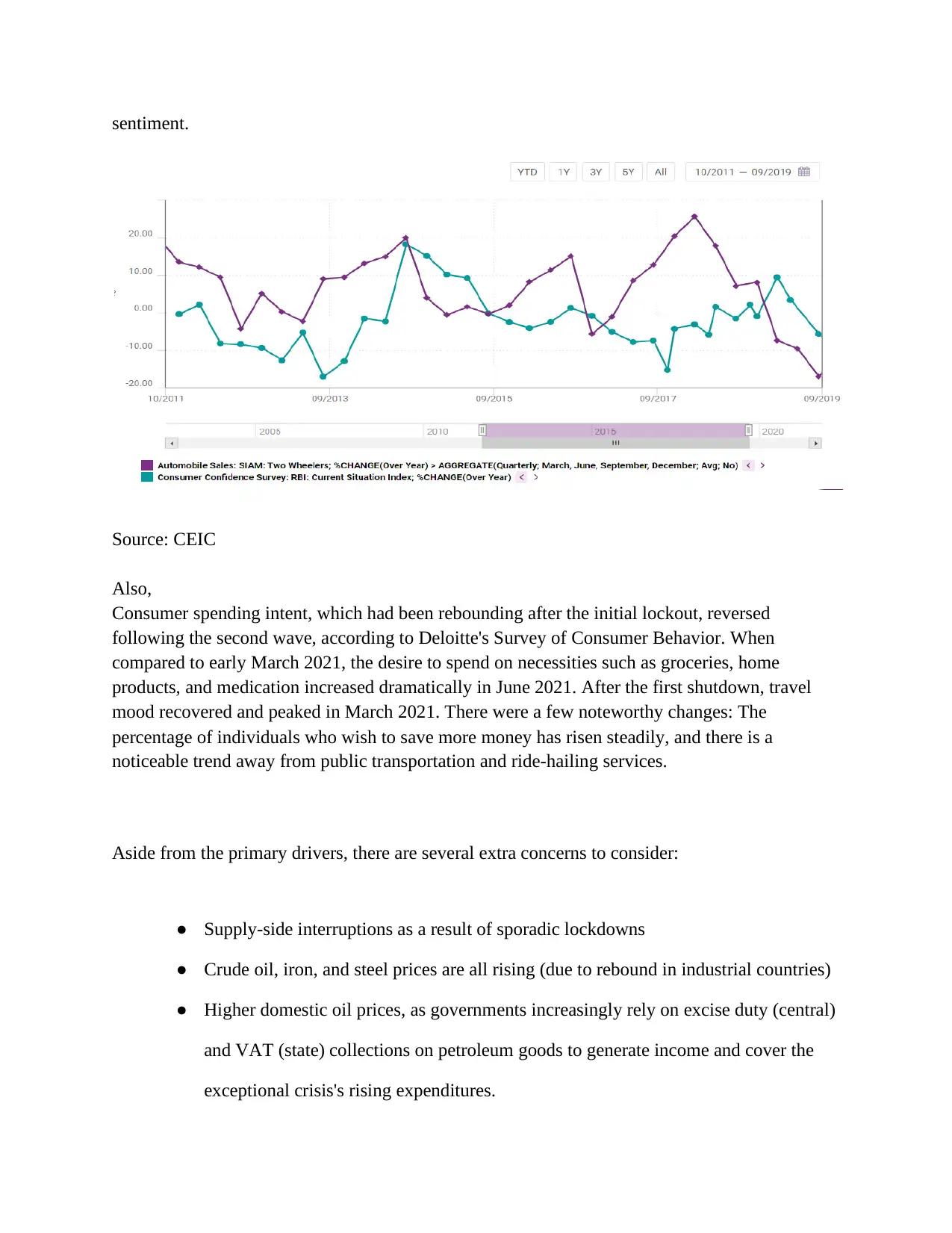
sentiment.
Source: CEIC
Also,
Consumer spending intent, which had been rebounding after the initial lockout, reversed
following the second wave, according to Deloitte's Survey of Consumer Behavior. When
compared to early March 2021, the desire to spend on necessities such as groceries, home
products, and medication increased dramatically in June 2021. After the first shutdown, travel
mood recovered and peaked in March 2021. There were a few noteworthy changes: The
percentage of individuals who wish to save more money has risen steadily, and there is a
noticeable trend away from public transportation and ride-hailing services.
Aside from the primary drivers, there are several extra concerns to consider:
● Supply-side interruptions as a result of sporadic lockdowns
● Crude oil, iron, and steel prices are all rising (due to rebound in industrial countries)
● Higher domestic oil prices, as governments increasingly rely on excise duty (central)
and VAT (state) collections on petroleum goods to generate income and cover the
exceptional crisis's rising expenditures.
Source: CEIC
Also,
Consumer spending intent, which had been rebounding after the initial lockout, reversed
following the second wave, according to Deloitte's Survey of Consumer Behavior. When
compared to early March 2021, the desire to spend on necessities such as groceries, home
products, and medication increased dramatically in June 2021. After the first shutdown, travel
mood recovered and peaked in March 2021. There were a few noteworthy changes: The
percentage of individuals who wish to save more money has risen steadily, and there is a
noticeable trend away from public transportation and ride-hailing services.
Aside from the primary drivers, there are several extra concerns to consider:
● Supply-side interruptions as a result of sporadic lockdowns
● Crude oil, iron, and steel prices are all rising (due to rebound in industrial countries)
● Higher domestic oil prices, as governments increasingly rely on excise duty (central)
and VAT (state) collections on petroleum goods to generate income and cover the
exceptional crisis's rising expenditures.
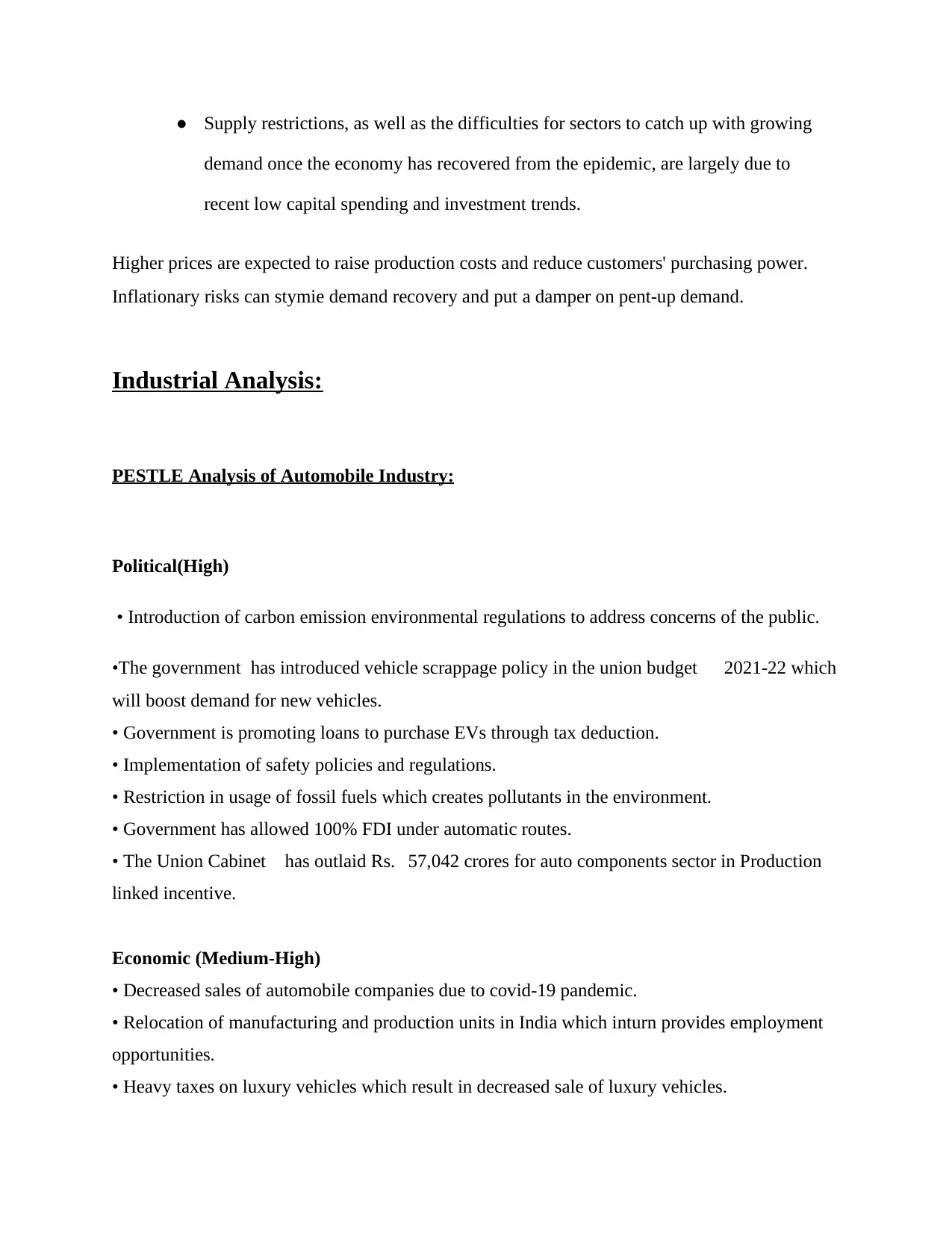
● Supply restrictions, as well as the difficulties for sectors to catch up with growing
demand once the economy has recovered from the epidemic, are largely due to
recent low capital spending and investment trends.
Higher prices are expected to raise production costs and reduce customers' purchasing power.
Inflationary risks can stymie demand recovery and put a damper on pent-up demand.
Industrial Analysis:
PESTLE Analysis of Automobile Industry:
Political(High)
• Introduction of carbon emission environmental regulations to address concerns of the public.
•The government has introduced vehicle scrappage policy in the union budget 2021-22 which
will boost demand for new vehicles.
• Government is promoting loans to purchase EVs through tax deduction.
• Implementation of safety policies and regulations.
• Restriction in usage of fossil fuels which creates pollutants in the environment.
• Government has allowed 100% FDI under automatic routes.
• The Union Cabinet has outlaid Rs. 57,042 crores for auto components sector in Production
linked incentive.
Economic (Medium-High)
• Decreased sales of automobile companies due to covid-19 pandemic.
• Relocation of manufacturing and production units in India which inturn provides employment
opportunities.
• Heavy taxes on luxury vehicles which result in decreased sale of luxury vehicles.
demand once the economy has recovered from the epidemic, are largely due to
recent low capital spending and investment trends.
Higher prices are expected to raise production costs and reduce customers' purchasing power.
Inflationary risks can stymie demand recovery and put a damper on pent-up demand.
Industrial Analysis:
PESTLE Analysis of Automobile Industry:
Political(High)
• Introduction of carbon emission environmental regulations to address concerns of the public.
•The government has introduced vehicle scrappage policy in the union budget 2021-22 which
will boost demand for new vehicles.
• Government is promoting loans to purchase EVs through tax deduction.
• Implementation of safety policies and regulations.
• Restriction in usage of fossil fuels which creates pollutants in the environment.
• Government has allowed 100% FDI under automatic routes.
• The Union Cabinet has outlaid Rs. 57,042 crores for auto components sector in Production
linked incentive.
Economic (Medium-High)
• Decreased sales of automobile companies due to covid-19 pandemic.
• Relocation of manufacturing and production units in India which inturn provides employment
opportunities.
• Heavy taxes on luxury vehicles which result in decreased sale of luxury vehicles.
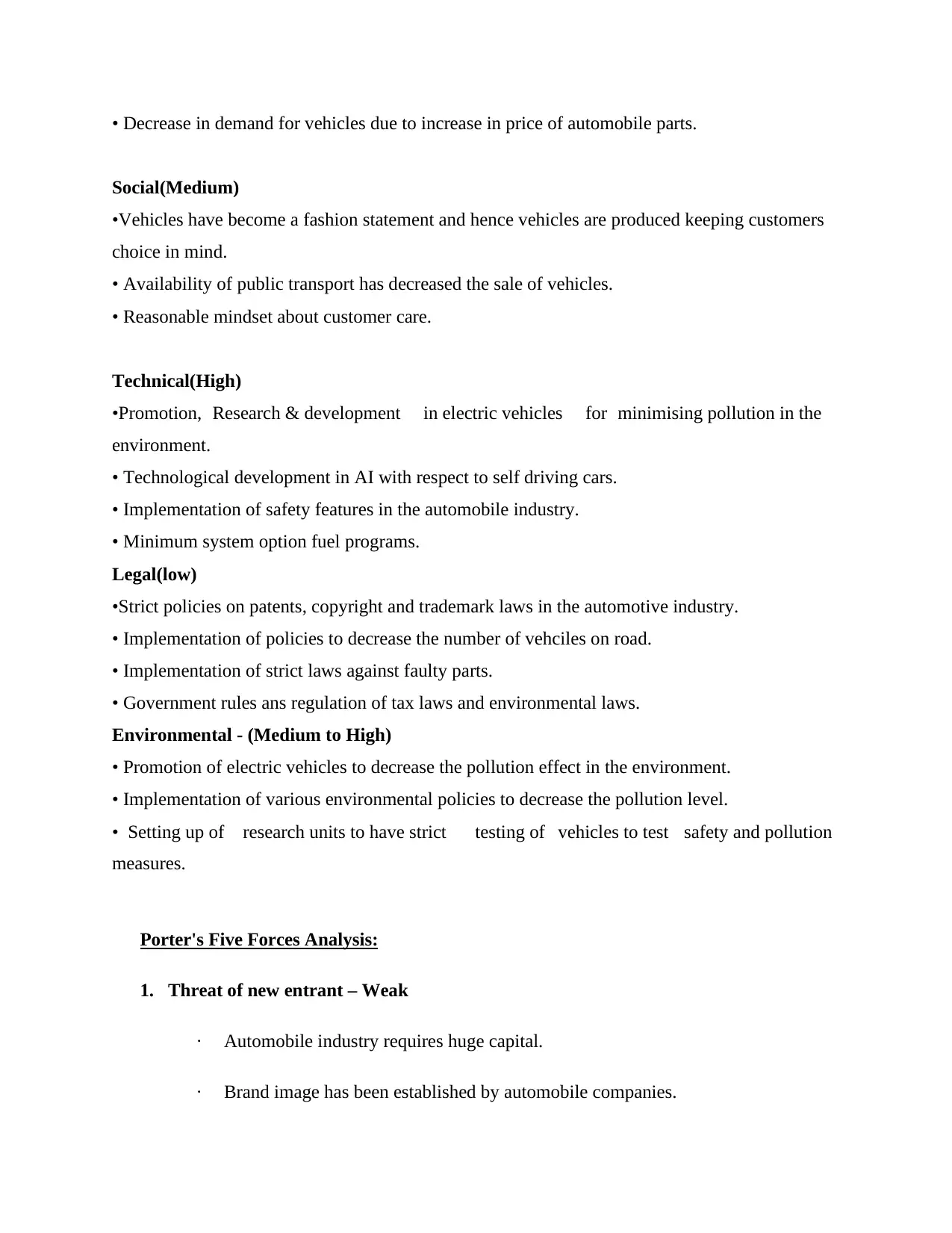
• Decrease in demand for vehicles due to increase in price of automobile parts.
Social(Medium)
•Vehicles have become a fashion statement and hence vehicles are produced keeping customers
choice in mind.
• Availability of public transport has decreased the sale of vehicles.
• Reasonable mindset about customer care.
Technical(High)
•Promotion, Research & development in electric vehicles for minimising pollution in the
environment.
• Technological development in AI with respect to self driving cars.
• Implementation of safety features in the automobile industry.
• Minimum system option fuel programs.
Legal(low)
•Strict policies on patents, copyright and trademark laws in the automotive industry.
• Implementation of policies to decrease the number of vehciles on road.
• Implementation of strict laws against faulty parts.
• Government rules ans regulation of tax laws and environmental laws.
Environmental - (Medium to High)
• Promotion of electric vehicles to decrease the pollution effect in the environment.
• Implementation of various environmental policies to decrease the pollution level.
• Setting up of research units to have strict testing of vehicles to test safety and pollution
measures.
Porter's Five Forces Analysis:
1. Threat of new entrant – Weak
· Automobile industry requires huge capital.
· Brand image has been established by automobile companies.
Social(Medium)
•Vehicles have become a fashion statement and hence vehicles are produced keeping customers
choice in mind.
• Availability of public transport has decreased the sale of vehicles.
• Reasonable mindset about customer care.
Technical(High)
•Promotion, Research & development in electric vehicles for minimising pollution in the
environment.
• Technological development in AI with respect to self driving cars.
• Implementation of safety features in the automobile industry.
• Minimum system option fuel programs.
Legal(low)
•Strict policies on patents, copyright and trademark laws in the automotive industry.
• Implementation of policies to decrease the number of vehciles on road.
• Implementation of strict laws against faulty parts.
• Government rules ans regulation of tax laws and environmental laws.
Environmental - (Medium to High)
• Promotion of electric vehicles to decrease the pollution effect in the environment.
• Implementation of various environmental policies to decrease the pollution level.
• Setting up of research units to have strict testing of vehicles to test safety and pollution
measures.
Porter's Five Forces Analysis:
1. Threat of new entrant – Weak
· Automobile industry requires huge capital.
· Brand image has been established by automobile companies.
Paraphrase This Document
Need a fresh take? Get an instant paraphrase of this document with our AI Paraphraser
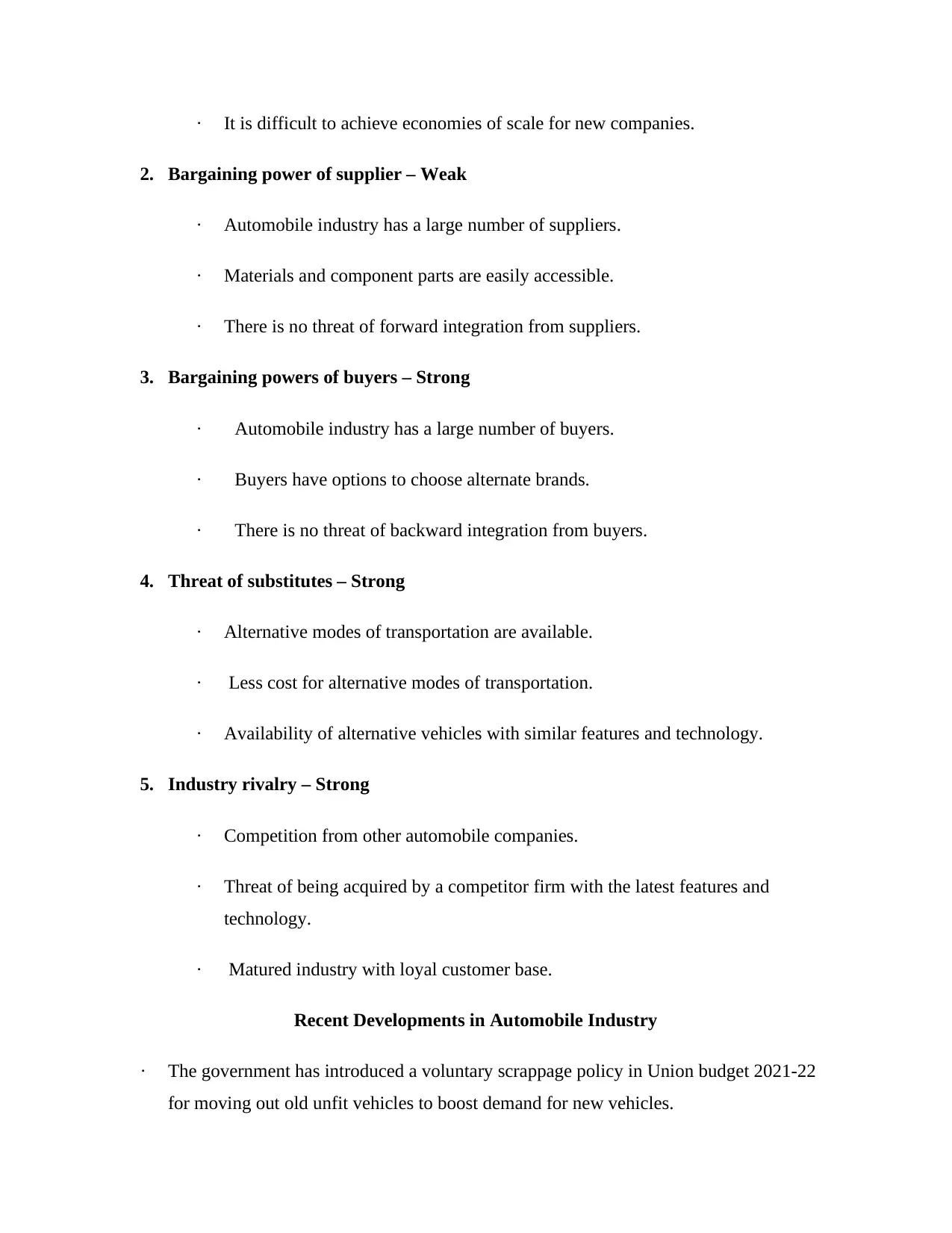
· It is difficult to achieve economies of scale for new companies.
2. Bargaining power of supplier – Weak
· Automobile industry has a large number of suppliers.
· Materials and component parts are easily accessible.
· There is no threat of forward integration from suppliers.
3. Bargaining powers of buyers – Strong
· Automobile industry has a large number of buyers.
· Buyers have options to choose alternate brands.
· There is no threat of backward integration from buyers.
4. Threat of substitutes – Strong
· Alternative modes of transportation are available.
· Less cost for alternative modes of transportation.
· Availability of alternative vehicles with similar features and technology.
5. Industry rivalry – Strong
· Competition from other automobile companies.
· Threat of being acquired by a competitor firm with the latest features and
technology.
· Matured industry with loyal customer base.
Recent Developments in Automobile Industry
· The government has introduced a voluntary scrappage policy in Union budget 2021-22
for moving out old unfit vehicles to boost demand for new vehicles.
2. Bargaining power of supplier – Weak
· Automobile industry has a large number of suppliers.
· Materials and component parts are easily accessible.
· There is no threat of forward integration from suppliers.
3. Bargaining powers of buyers – Strong
· Automobile industry has a large number of buyers.
· Buyers have options to choose alternate brands.
· There is no threat of backward integration from buyers.
4. Threat of substitutes – Strong
· Alternative modes of transportation are available.
· Less cost for alternative modes of transportation.
· Availability of alternative vehicles with similar features and technology.
5. Industry rivalry – Strong
· Competition from other automobile companies.
· Threat of being acquired by a competitor firm with the latest features and
technology.
· Matured industry with loyal customer base.
Recent Developments in Automobile Industry
· The government has introduced a voluntary scrappage policy in Union budget 2021-22
for moving out old unfit vehicles to boost demand for new vehicles.
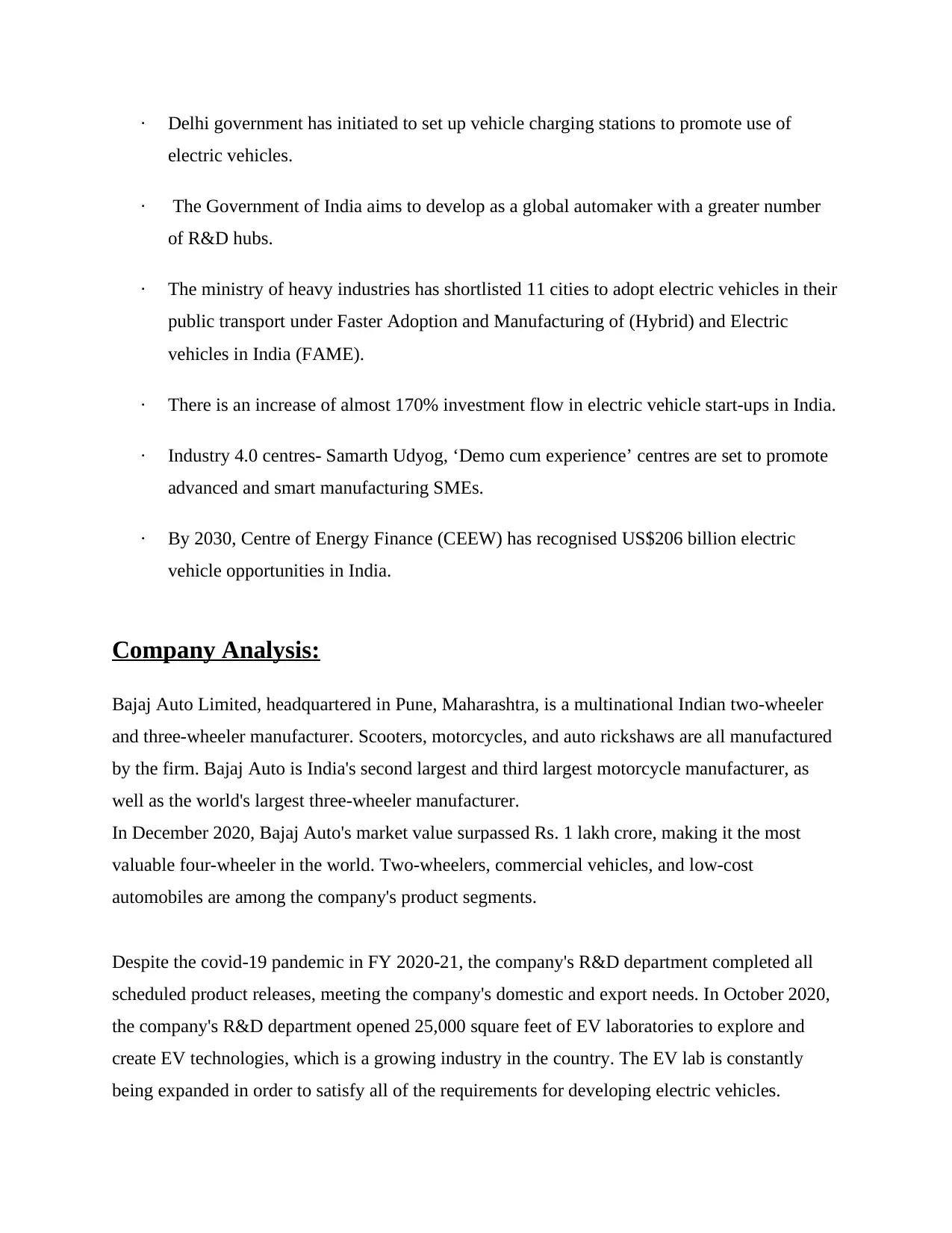
· Delhi government has initiated to set up vehicle charging stations to promote use of
electric vehicles.
· The Government of India aims to develop as a global automaker with a greater number
of R&D hubs.
· The ministry of heavy industries has shortlisted 11 cities to adopt electric vehicles in their
public transport under Faster Adoption and Manufacturing of (Hybrid) and Electric
vehicles in India (FAME).
· There is an increase of almost 170% investment flow in electric vehicle start-ups in India.
· Industry 4.0 centres- Samarth Udyog, ‘Demo cum experience’ centres are set to promote
advanced and smart manufacturing SMEs.
· By 2030, Centre of Energy Finance (CEEW) has recognised US$206 billion electric
vehicle opportunities in India.
Company Analysis:
Bajaj Auto Limited, headquartered in Pune, Maharashtra, is a multinational Indian two-wheeler
and three-wheeler manufacturer. Scooters, motorcycles, and auto rickshaws are all manufactured
by the firm. Bajaj Auto is India's second largest and third largest motorcycle manufacturer, as
well as the world's largest three-wheeler manufacturer.
In December 2020, Bajaj Auto's market value surpassed Rs. 1 lakh crore, making it the most
valuable four-wheeler in the world. Two-wheelers, commercial vehicles, and low-cost
automobiles are among the company's product segments.
Despite the covid-19 pandemic in FY 2020-21, the company's R&D department completed all
scheduled product releases, meeting the company's domestic and export needs. In October 2020,
the company's R&D department opened 25,000 square feet of EV laboratories to explore and
create EV technologies, which is a growing industry in the country. The EV lab is constantly
being expanded in order to satisfy all of the requirements for developing electric vehicles.
electric vehicles.
· The Government of India aims to develop as a global automaker with a greater number
of R&D hubs.
· The ministry of heavy industries has shortlisted 11 cities to adopt electric vehicles in their
public transport under Faster Adoption and Manufacturing of (Hybrid) and Electric
vehicles in India (FAME).
· There is an increase of almost 170% investment flow in electric vehicle start-ups in India.
· Industry 4.0 centres- Samarth Udyog, ‘Demo cum experience’ centres are set to promote
advanced and smart manufacturing SMEs.
· By 2030, Centre of Energy Finance (CEEW) has recognised US$206 billion electric
vehicle opportunities in India.
Company Analysis:
Bajaj Auto Limited, headquartered in Pune, Maharashtra, is a multinational Indian two-wheeler
and three-wheeler manufacturer. Scooters, motorcycles, and auto rickshaws are all manufactured
by the firm. Bajaj Auto is India's second largest and third largest motorcycle manufacturer, as
well as the world's largest three-wheeler manufacturer.
In December 2020, Bajaj Auto's market value surpassed Rs. 1 lakh crore, making it the most
valuable four-wheeler in the world. Two-wheelers, commercial vehicles, and low-cost
automobiles are among the company's product segments.
Despite the covid-19 pandemic in FY 2020-21, the company's R&D department completed all
scheduled product releases, meeting the company's domestic and export needs. In October 2020,
the company's R&D department opened 25,000 square feet of EV laboratories to explore and
create EV technologies, which is a growing industry in the country. The EV lab is constantly
being expanded in order to satisfy all of the requirements for developing electric vehicles.
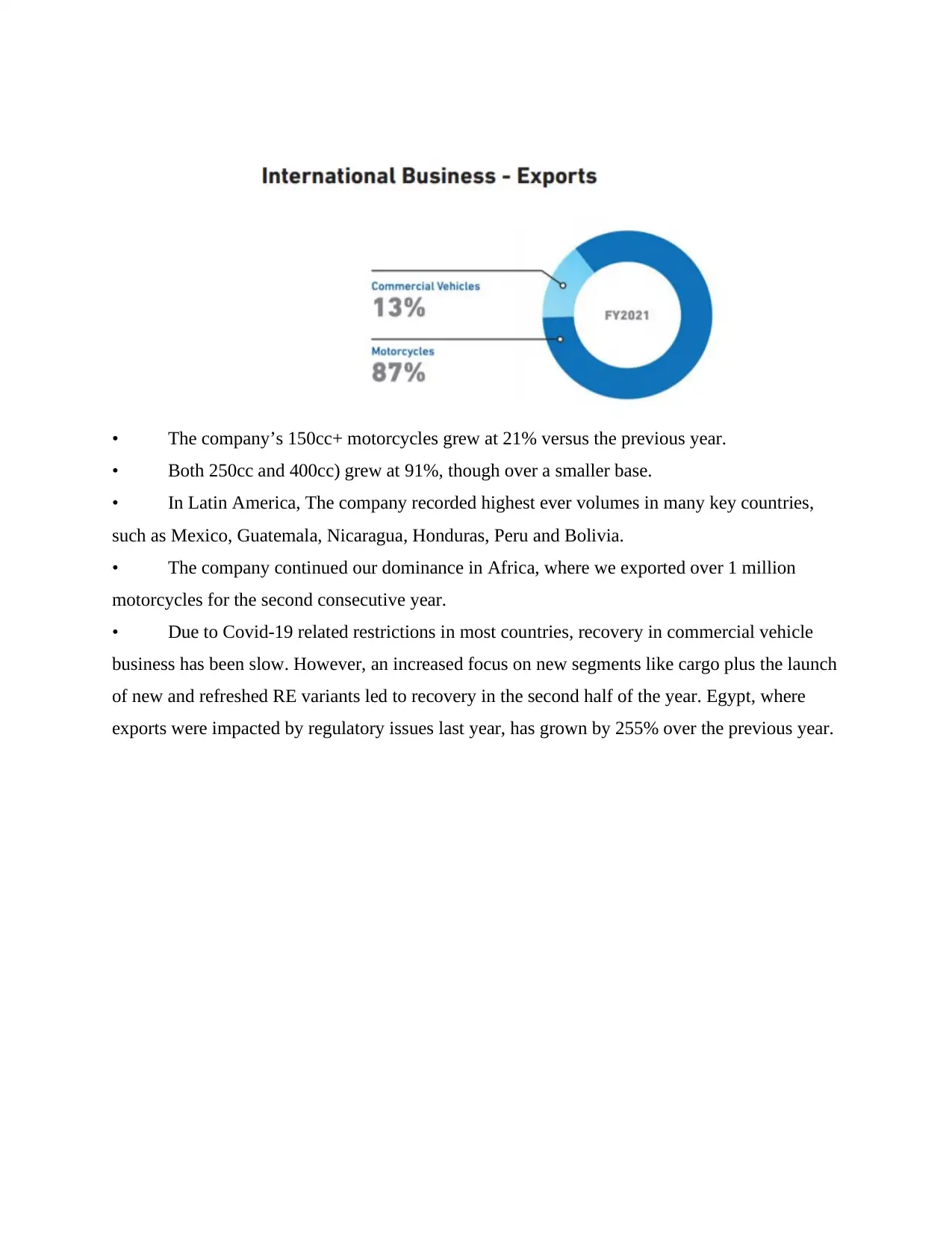
• The company’s 150cc+ motorcycles grew at 21% versus the previous year.
• Both 250cc and 400cc) grew at 91%, though over a smaller base.
• In Latin America, The company recorded highest ever volumes in many key countries,
such as Mexico, Guatemala, Nicaragua, Honduras, Peru and Bolivia.
• The company continued our dominance in Africa, where we exported over 1 million
motorcycles for the second consecutive year.
• Due to Covid-19 related restrictions in most countries, recovery in commercial vehicle
business has been slow. However, an increased focus on new segments like cargo plus the launch
of new and refreshed RE variants led to recovery in the second half of the year. Egypt, where
exports were impacted by regulatory issues last year, has grown by 255% over the previous year.
• Both 250cc and 400cc) grew at 91%, though over a smaller base.
• In Latin America, The company recorded highest ever volumes in many key countries,
such as Mexico, Guatemala, Nicaragua, Honduras, Peru and Bolivia.
• The company continued our dominance in Africa, where we exported over 1 million
motorcycles for the second consecutive year.
• Due to Covid-19 related restrictions in most countries, recovery in commercial vehicle
business has been slow. However, an increased focus on new segments like cargo plus the launch
of new and refreshed RE variants led to recovery in the second half of the year. Egypt, where
exports were impacted by regulatory issues last year, has grown by 255% over the previous year.
Secure Best Marks with AI Grader
Need help grading? Try our AI Grader for instant feedback on your assignments.
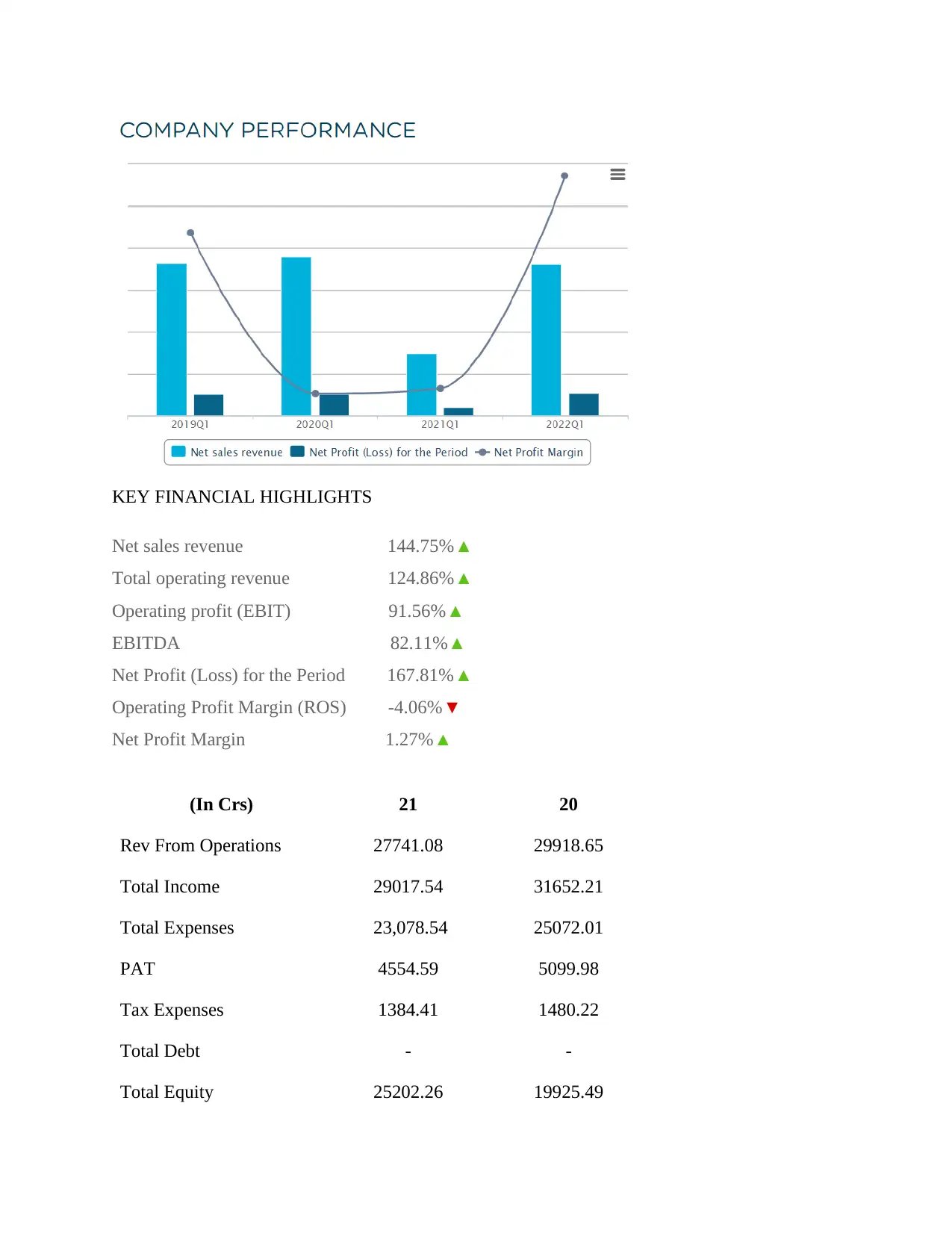
KEY FINANCIAL HIGHLIGHTS
Net sales revenue 144.75%▲
Total operating revenue 124.86%▲
Operating profit (EBIT) 91.56%▲
EBITDA 82.11%▲
Net Profit (Loss) for the Period 167.81%▲
Operating Profit Margin (ROS) -4.06%▼
Net Profit Margin 1.27%▲
(In Crs) 21 20
Rev From Operations 27741.08 29918.65
Total Income 29017.54 31652.21
Total Expenses 23,078.54 25072.01
PAT 4554.59 5099.98
Tax Expenses 1384.41 1480.22
Total Debt - -
Total Equity 25202.26 19925.49
Net sales revenue 144.75%▲
Total operating revenue 124.86%▲
Operating profit (EBIT) 91.56%▲
EBITDA 82.11%▲
Net Profit (Loss) for the Period 167.81%▲
Operating Profit Margin (ROS) -4.06%▼
Net Profit Margin 1.27%▲
(In Crs) 21 20
Rev From Operations 27741.08 29918.65
Total Income 29017.54 31652.21
Total Expenses 23,078.54 25072.01
PAT 4554.59 5099.98
Tax Expenses 1384.41 1480.22
Total Debt - -
Total Equity 25202.26 19925.49
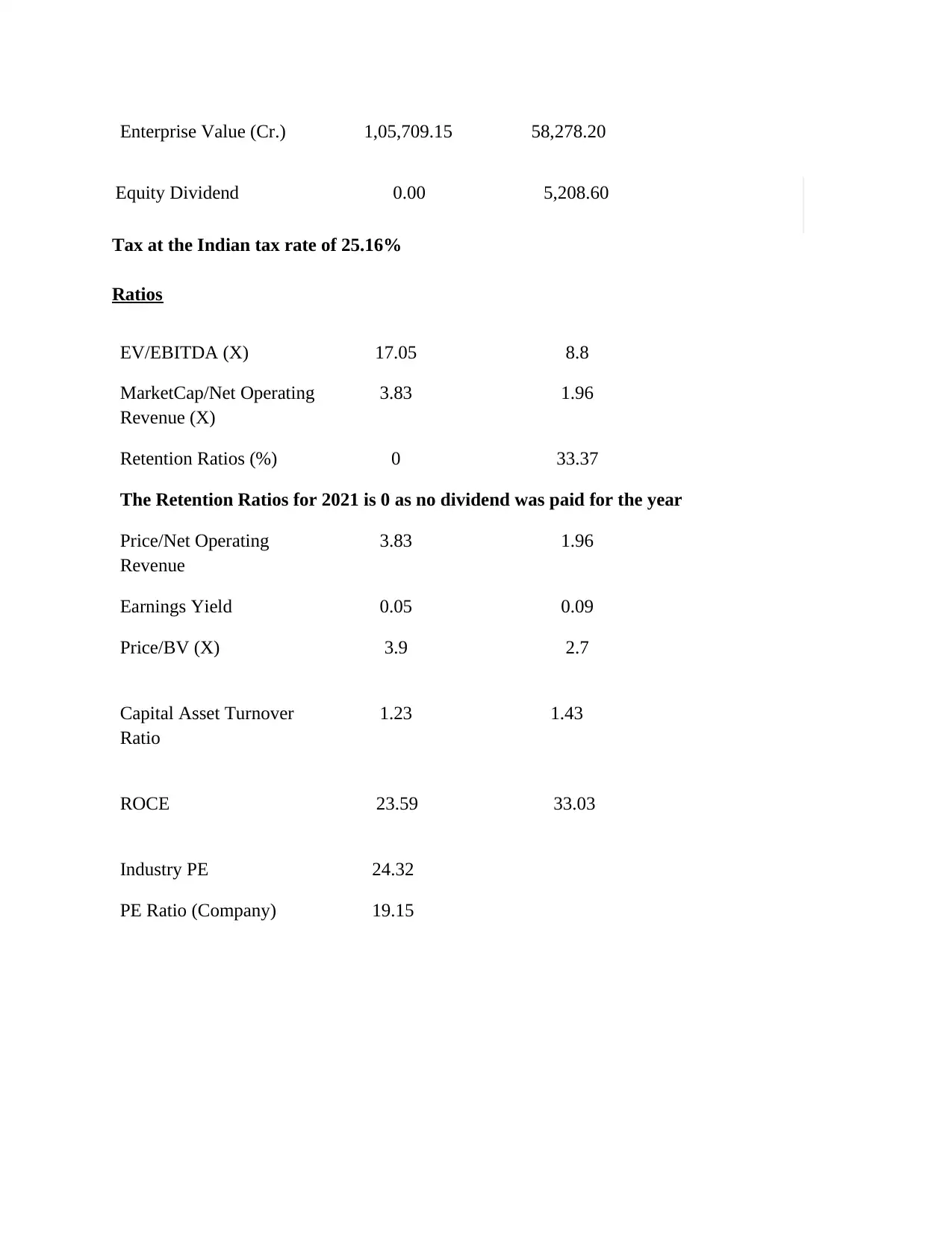
Enterprise Value (Cr.) 1,05,709.15 58,278.20
Equity Dividend 0.00 5,208.60
Tax at the Indian tax rate of 25.16%
Ratios
EV/EBITDA (X) 17.05 8.8
MarketCap/Net Operating
Revenue (X)
3.83 1.96
Retention Ratios (%) 0 33.37
The Retention Ratios for 2021 is 0 as no dividend was paid for the year
Price/Net Operating
Revenue
3.83 1.96
Earnings Yield 0.05 0.09
Price/BV (X) 3.9 2.7
Capital Asset Turnover
Ratio
1.23 1.43
ROCE 23.59 33.03
Industry PE 24.32
PE Ratio (Company) 19.15
Equity Dividend 0.00 5,208.60
Tax at the Indian tax rate of 25.16%
Ratios
EV/EBITDA (X) 17.05 8.8
MarketCap/Net Operating
Revenue (X)
3.83 1.96
Retention Ratios (%) 0 33.37
The Retention Ratios for 2021 is 0 as no dividend was paid for the year
Price/Net Operating
Revenue
3.83 1.96
Earnings Yield 0.05 0.09
Price/BV (X) 3.9 2.7
Capital Asset Turnover
Ratio
1.23 1.43
ROCE 23.59 33.03
Industry PE 24.32
PE Ratio (Company) 19.15
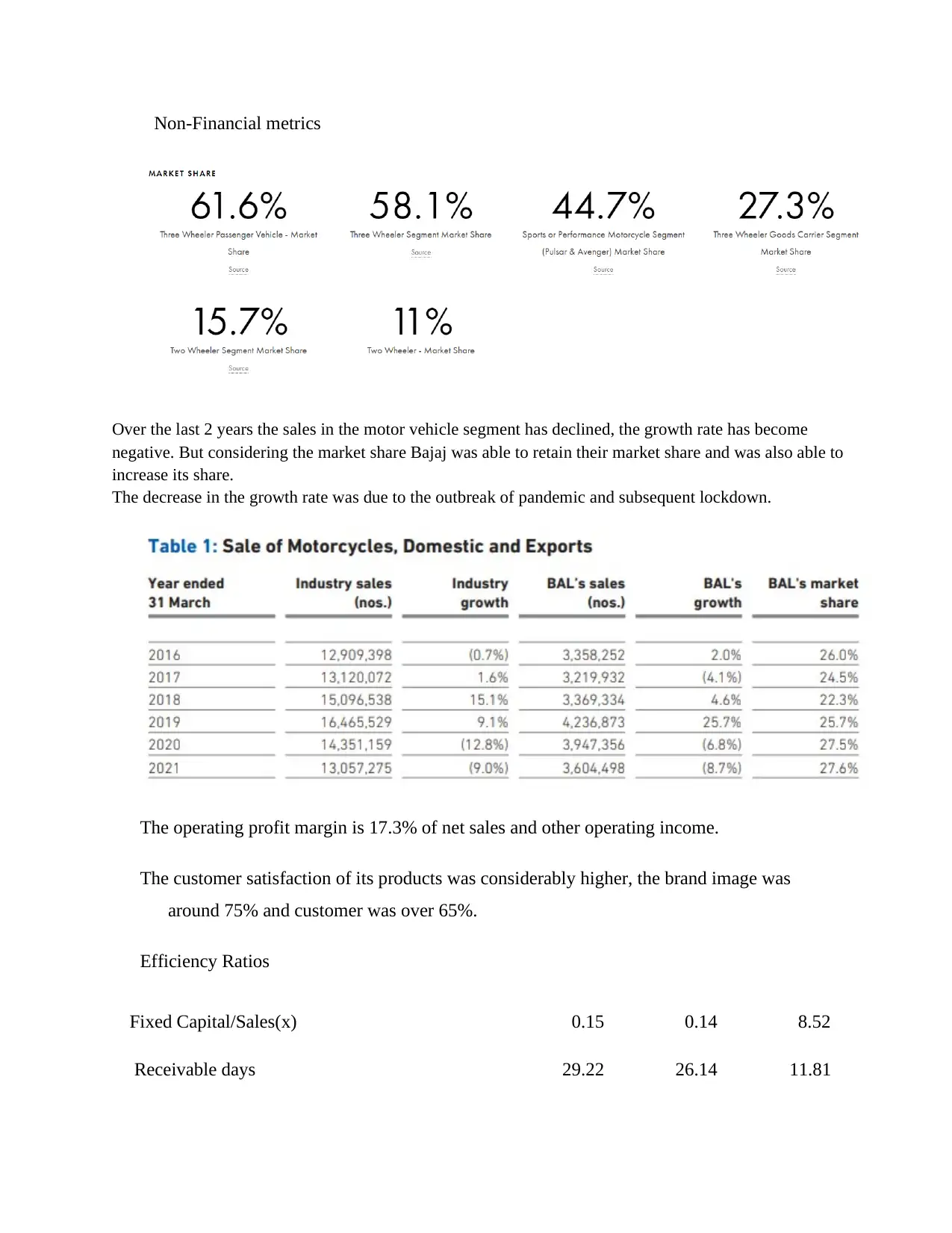
Non-Financial metrics
Over the last 2 years the sales in the motor vehicle segment has declined, the growth rate has become
negative. But considering the market share Bajaj was able to retain their market share and was also able to
increase its share.
The decrease in the growth rate was due to the outbreak of pandemic and subsequent lockdown.
The operating profit margin is 17.3% of net sales and other operating income.
The customer satisfaction of its products was considerably higher, the brand image was
around 75% and customer was over 65%.
Efficiency Ratios
Fixed Capital/Sales(x) 0.15 0.14 8.52
Receivable days 29.22 26.14 11.81
Over the last 2 years the sales in the motor vehicle segment has declined, the growth rate has become
negative. But considering the market share Bajaj was able to retain their market share and was also able to
increase its share.
The decrease in the growth rate was due to the outbreak of pandemic and subsequent lockdown.
The operating profit margin is 17.3% of net sales and other operating income.
The customer satisfaction of its products was considerably higher, the brand image was
around 75% and customer was over 65%.
Efficiency Ratios
Fixed Capital/Sales(x) 0.15 0.14 8.52
Receivable days 29.22 26.14 11.81
Paraphrase This Document
Need a fresh take? Get an instant paraphrase of this document with our AI Paraphraser
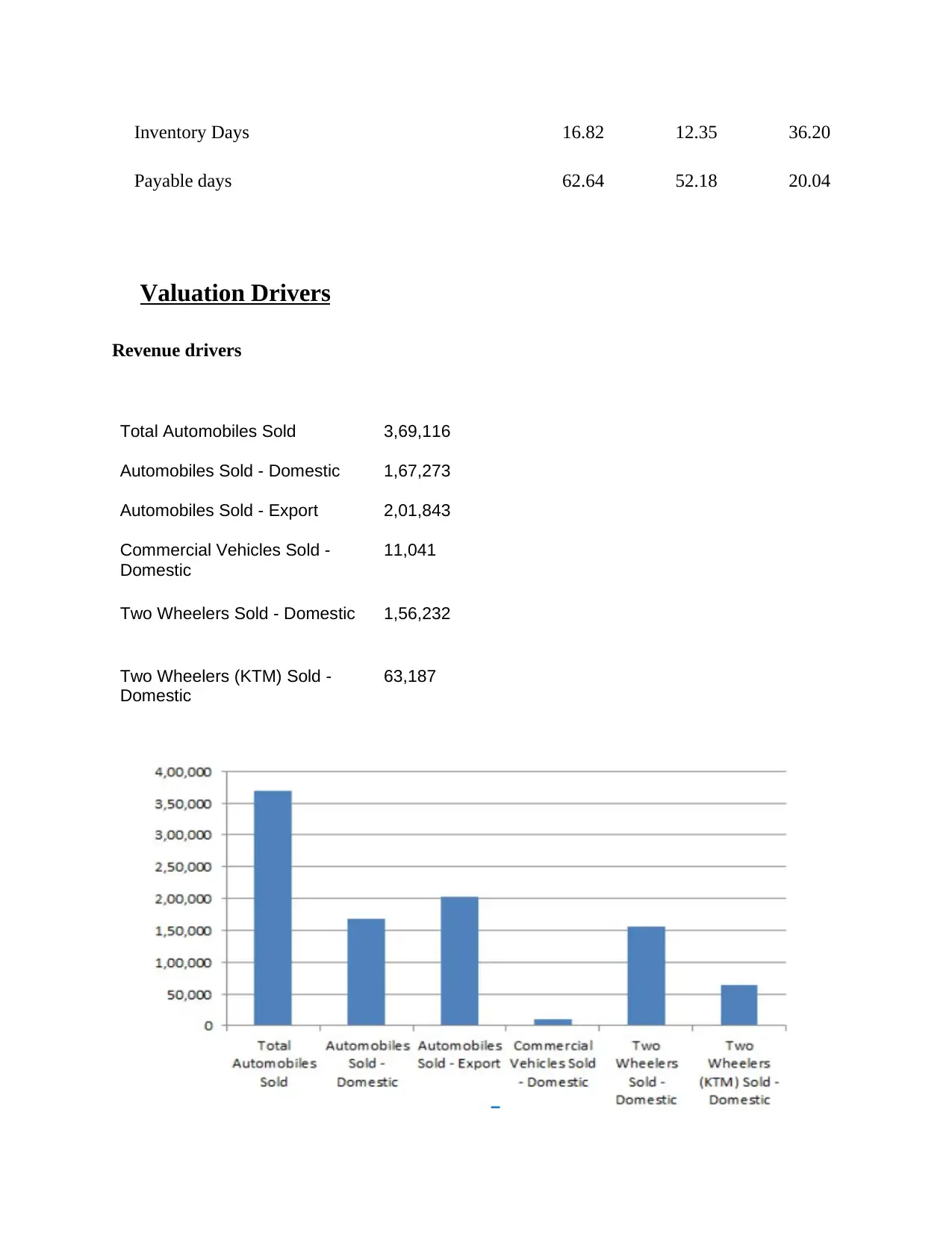
Inventory Days 16.82 12.35 36.20
Payable days 62.64 52.18 20.04
Valuation Drivers
Revenue drivers
Total Automobiles Sold 3,69,116
Automobiles Sold - Domestic 1,67,273
Automobiles Sold - Export 2,01,843
Commercial Vehicles Sold -
Domestic
11,041
Two Wheelers Sold - Domestic 1,56,232
Two Wheelers (KTM) Sold -
Domestic
63,187
Payable days 62.64 52.18 20.04
Valuation Drivers
Revenue drivers
Total Automobiles Sold 3,69,116
Automobiles Sold - Domestic 1,67,273
Automobiles Sold - Export 2,01,843
Commercial Vehicles Sold -
Domestic
11,041
Two Wheelers Sold - Domestic 1,56,232
Two Wheelers (KTM) Sold -
Domestic
63,187
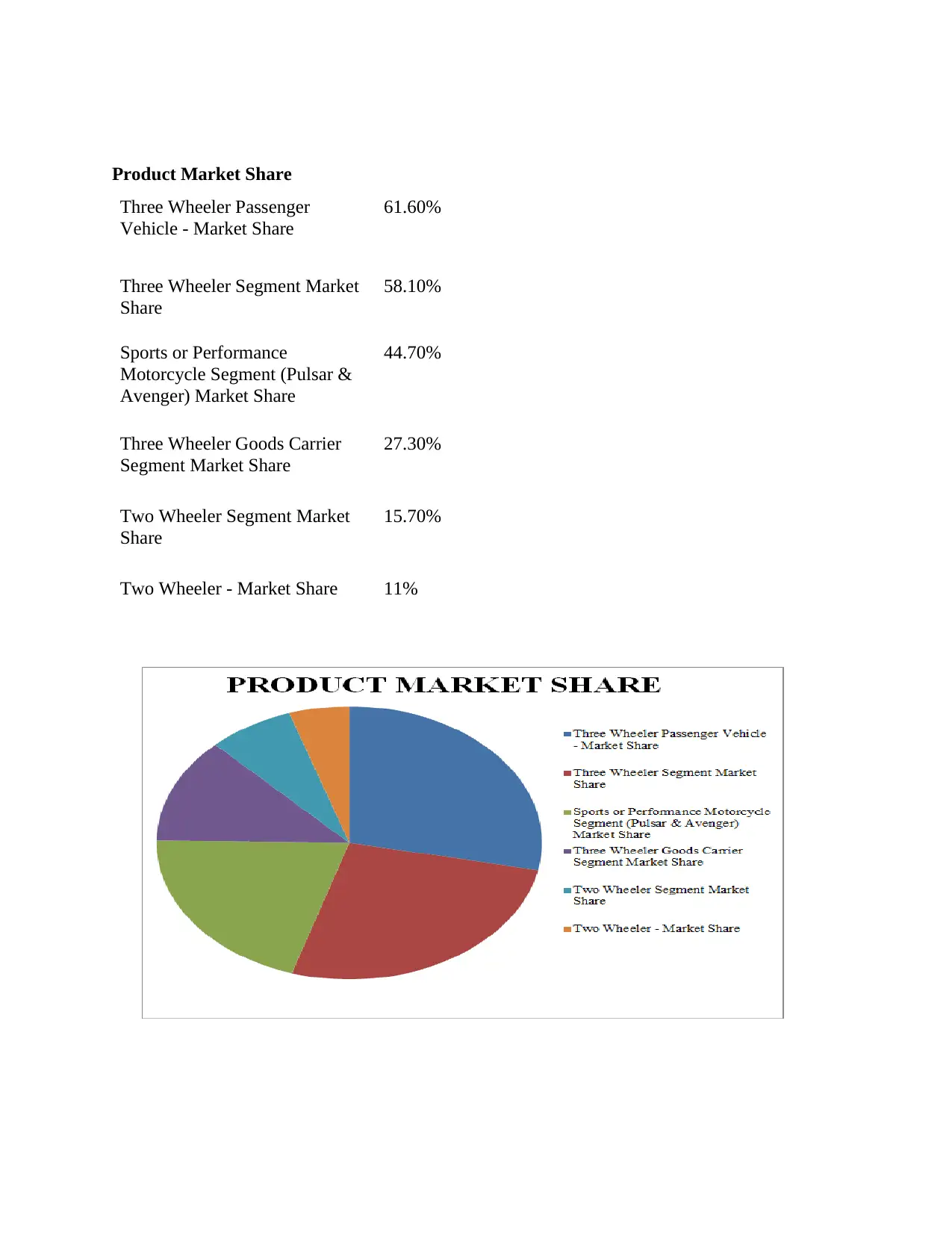
Product Market Share
Three Wheeler Passenger
Vehicle - Market Share
61.60%
Three Wheeler Segment Market
Share
58.10%
Sports or Performance
Motorcycle Segment (Pulsar &
Avenger) Market Share
44.70%
Three Wheeler Goods Carrier
Segment Market Share
27.30%
Two Wheeler Segment Market
Share
15.70%
Two Wheeler - Market Share 11%
Three Wheeler Passenger
Vehicle - Market Share
61.60%
Three Wheeler Segment Market
Share
58.10%
Sports or Performance
Motorcycle Segment (Pulsar &
Avenger) Market Share
44.70%
Three Wheeler Goods Carrier
Segment Market Share
27.30%
Two Wheeler Segment Market
Share
15.70%
Two Wheeler - Market Share 11%
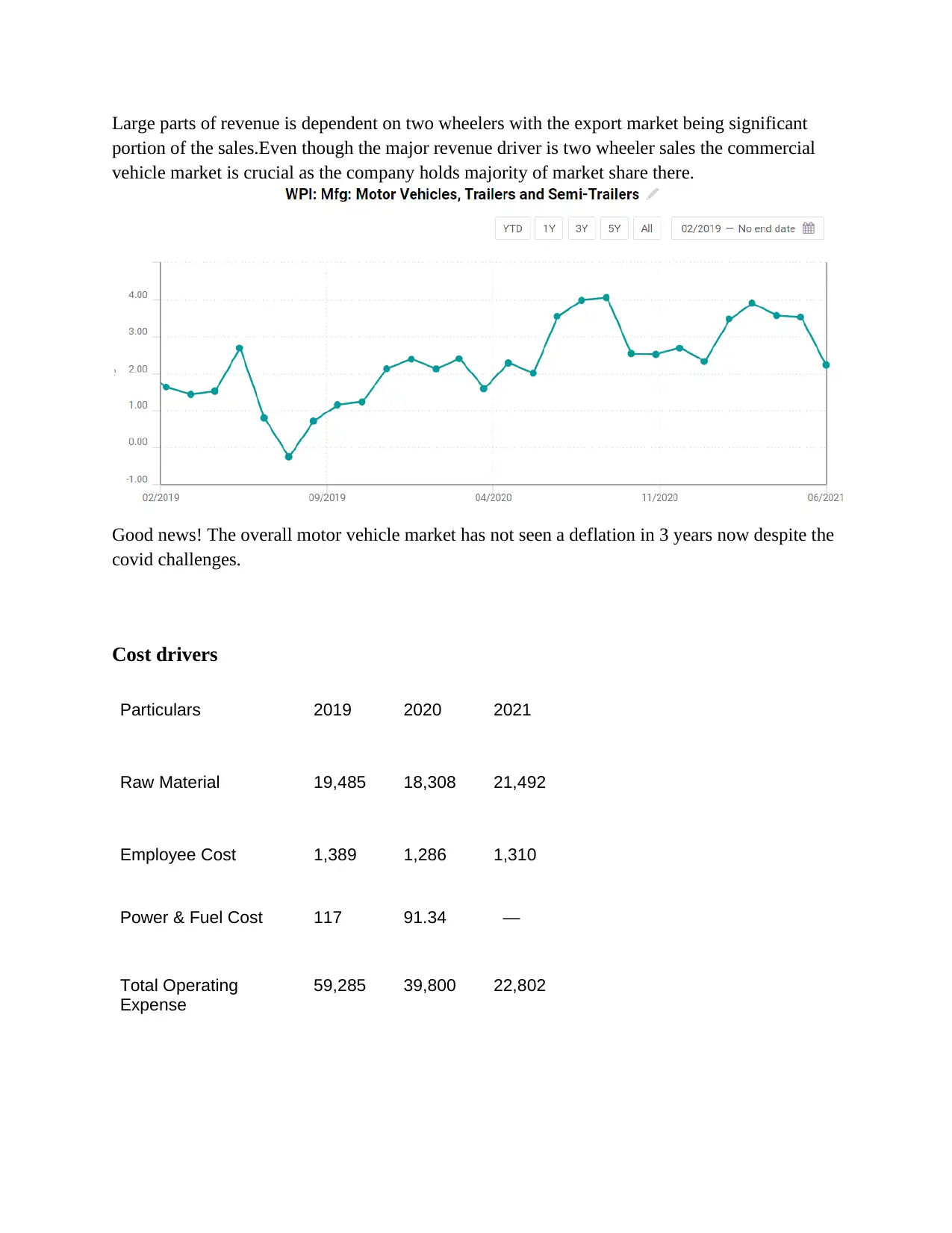
Large parts of revenue is dependent on two wheelers with the export market being significant
portion of the sales.Even though the major revenue driver is two wheeler sales the commercial
vehicle market is crucial as the company holds majority of market share there.
Good news! The overall motor vehicle market has not seen a deflation in 3 years now despite the
covid challenges.
Cost drivers
Particulars 2019 2020 2021
Raw Material 19,485 18,308 21,492
Employee Cost 1,389 1,286 1,310
Power & Fuel Cost 117 91.34 —
Total Operating
Expense
59,285 39,800 22,802
portion of the sales.Even though the major revenue driver is two wheeler sales the commercial
vehicle market is crucial as the company holds majority of market share there.
Good news! The overall motor vehicle market has not seen a deflation in 3 years now despite the
covid challenges.
Cost drivers
Particulars 2019 2020 2021
Raw Material 19,485 18,308 21,492
Employee Cost 1,389 1,286 1,310
Power & Fuel Cost 117 91.34 —
Total Operating
Expense
59,285 39,800 22,802
Secure Best Marks with AI Grader
Need help grading? Try our AI Grader for instant feedback on your assignments.
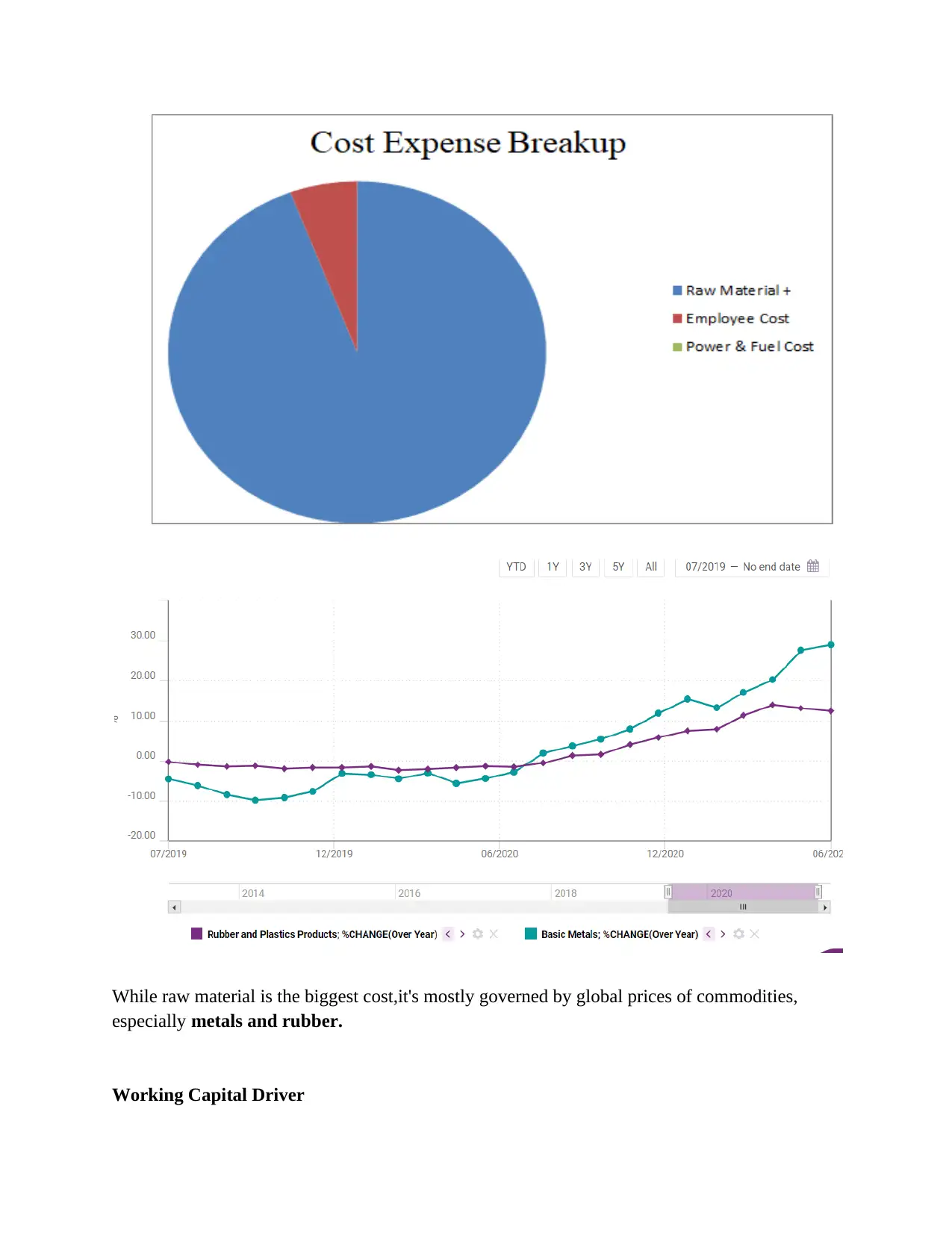
While raw material is the biggest cost,it's mostly governed by global prices of commodities,
especially metals and rubber.
Working Capital Driver
especially metals and rubber.
Working Capital Driver
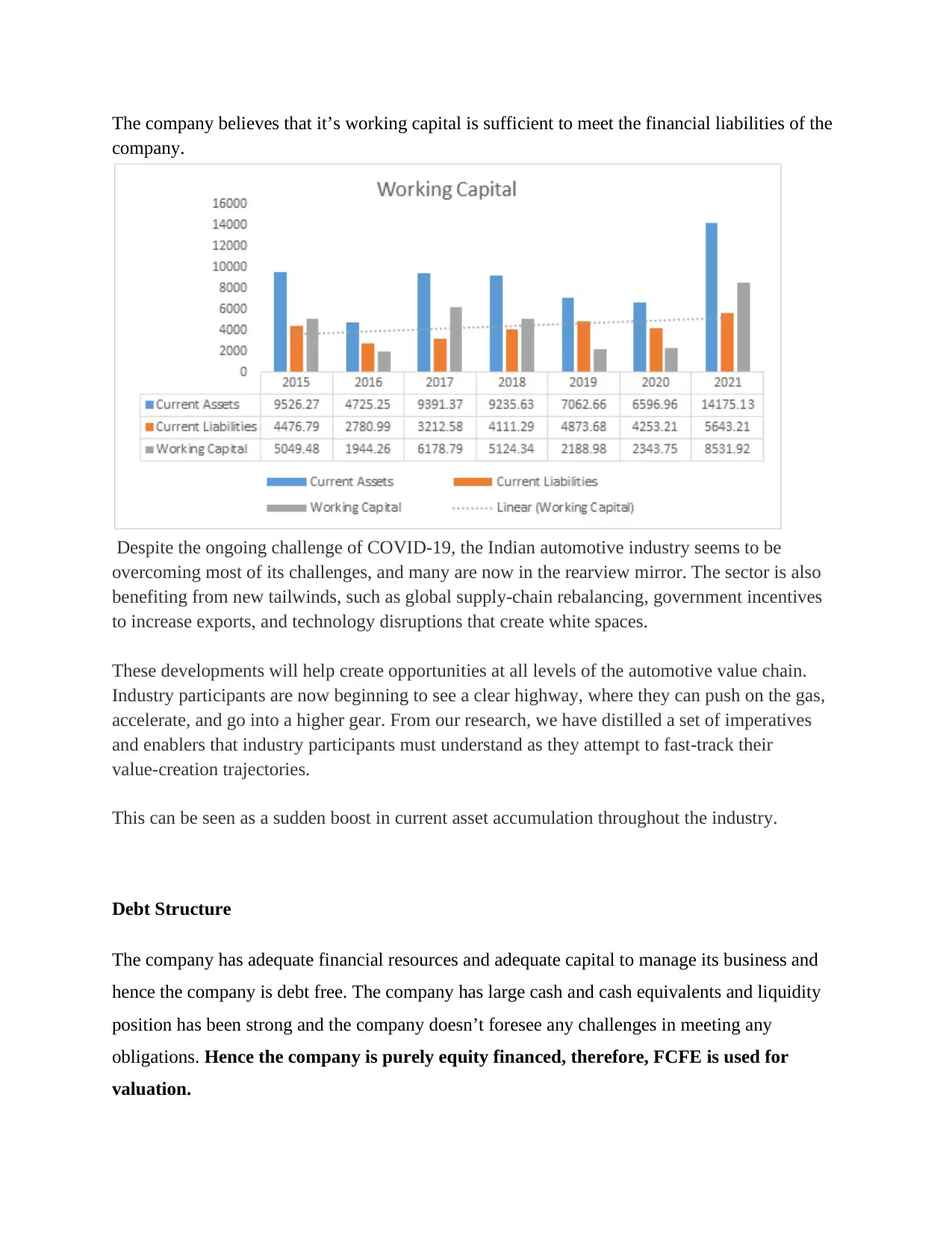
The company believes that it’s working capital is sufficient to meet the financial liabilities of the
company.
Despite the ongoing challenge of COVID-19, the Indian automotive industry seems to be
overcoming most of its challenges, and many are now in the rearview mirror. The sector is also
benefiting from new tailwinds, such as global supply-chain rebalancing, government incentives
to increase exports, and technology disruptions that create white spaces.
These developments will help create opportunities at all levels of the automotive value chain.
Industry participants are now beginning to see a clear highway, where they can push on the gas,
accelerate, and go into a higher gear. From our research, we have distilled a set of imperatives
and enablers that industry participants must understand as they attempt to fast-track their
value-creation trajectories.
This can be seen as a sudden boost in current asset accumulation throughout the industry.
Debt Structure
The company has adequate financial resources and adequate capital to manage its business and
hence the company is debt free. The company has large cash and cash equivalents and liquidity
position has been strong and the company doesn’t foresee any challenges in meeting any
obligations. Hence the company is purely equity financed, therefore, FCFE is used for
valuation.
company.
Despite the ongoing challenge of COVID-19, the Indian automotive industry seems to be
overcoming most of its challenges, and many are now in the rearview mirror. The sector is also
benefiting from new tailwinds, such as global supply-chain rebalancing, government incentives
to increase exports, and technology disruptions that create white spaces.
These developments will help create opportunities at all levels of the automotive value chain.
Industry participants are now beginning to see a clear highway, where they can push on the gas,
accelerate, and go into a higher gear. From our research, we have distilled a set of imperatives
and enablers that industry participants must understand as they attempt to fast-track their
value-creation trajectories.
This can be seen as a sudden boost in current asset accumulation throughout the industry.
Debt Structure
The company has adequate financial resources and adequate capital to manage its business and
hence the company is debt free. The company has large cash and cash equivalents and liquidity
position has been strong and the company doesn’t foresee any challenges in meeting any
obligations. Hence the company is purely equity financed, therefore, FCFE is used for
valuation.
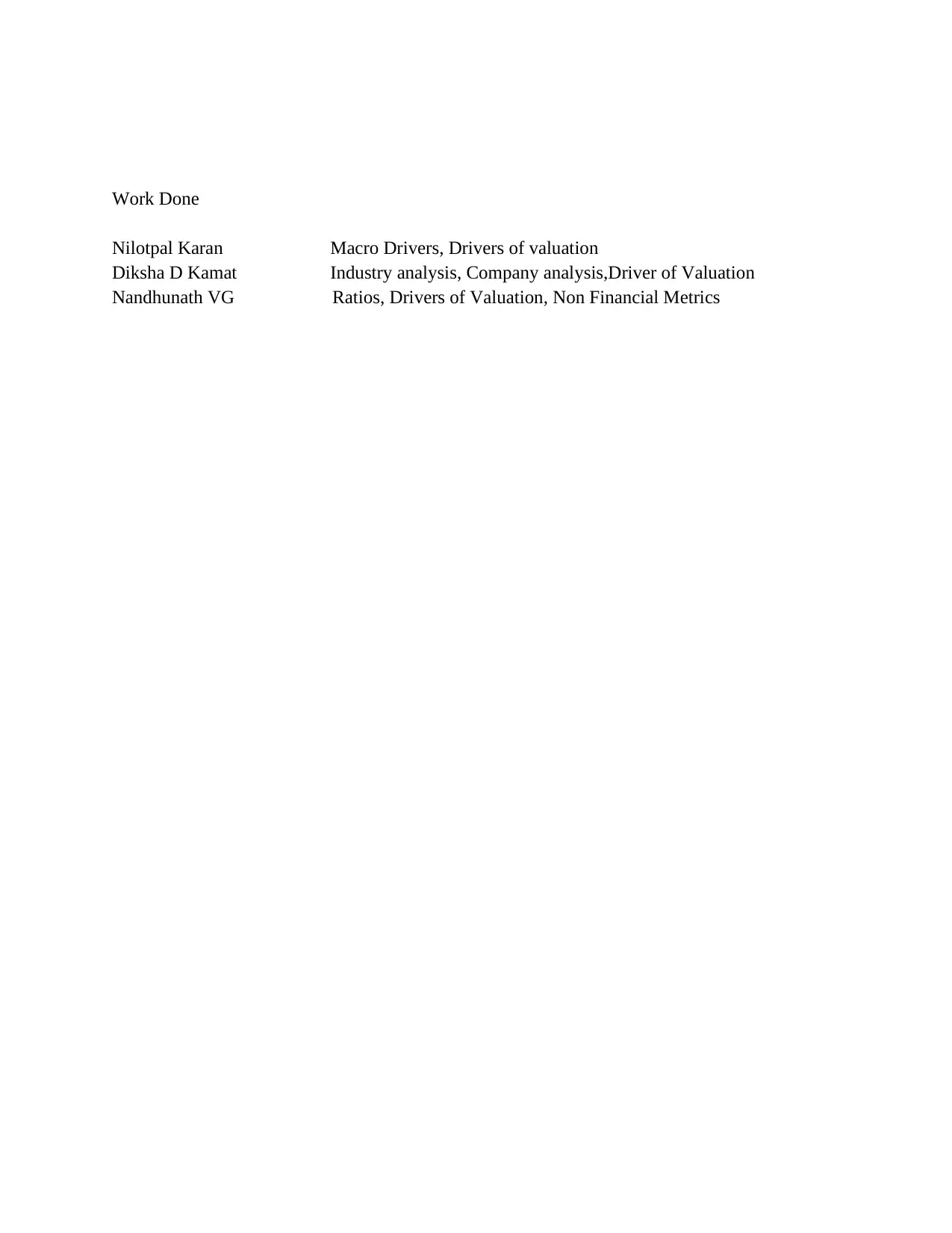
Work Done
Nilotpal Karan Macro Drivers, Drivers of valuation
Diksha D Kamat Industry analysis, Company analysis,Driver of Valuation
Nandhunath VG Ratios, Drivers of Valuation, Non Financial Metrics
Nilotpal Karan Macro Drivers, Drivers of valuation
Diksha D Kamat Industry analysis, Company analysis,Driver of Valuation
Nandhunath VG Ratios, Drivers of Valuation, Non Financial Metrics
Paraphrase This Document
Need a fresh take? Get an instant paraphrase of this document with our AI Paraphraser
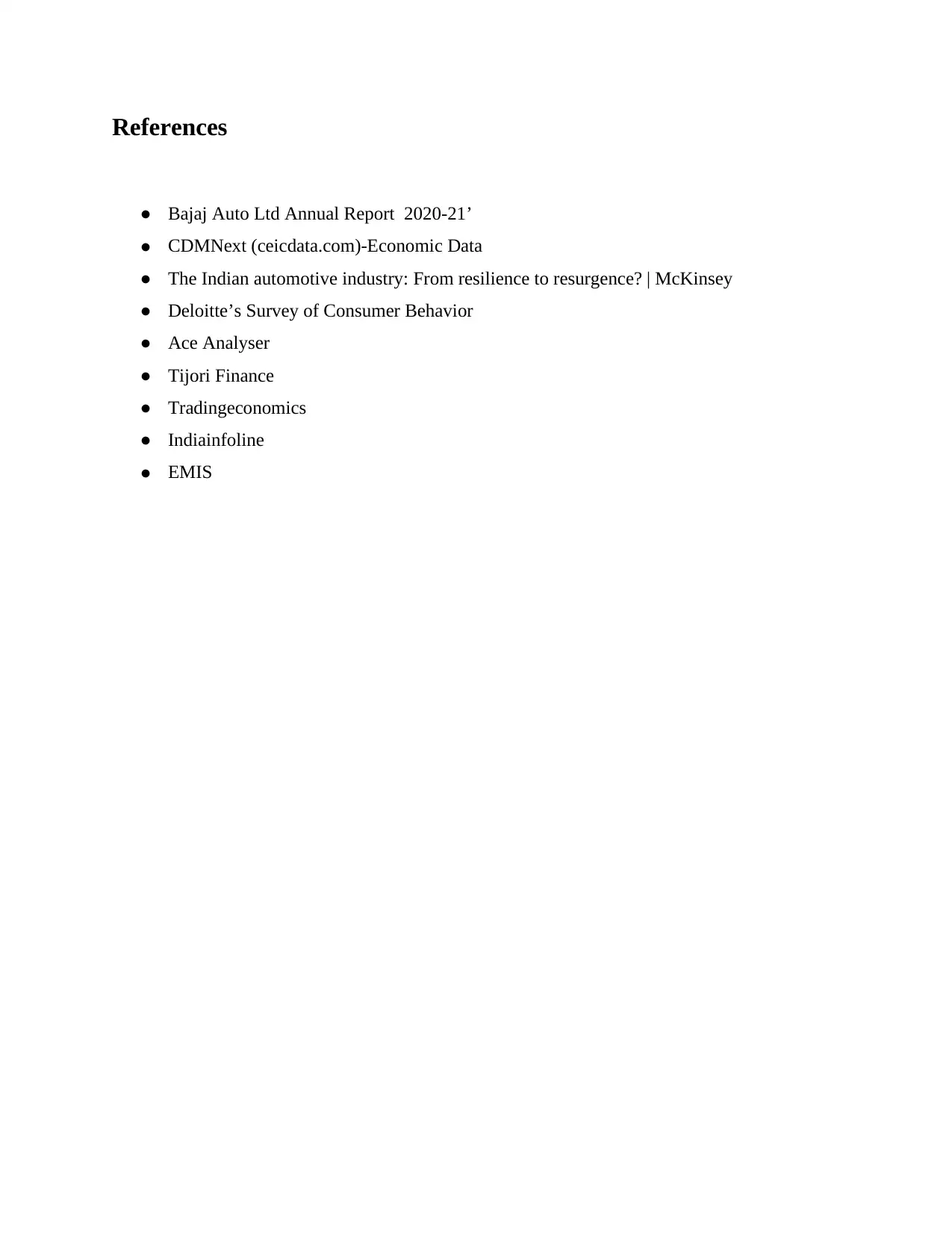
References
● Bajaj Auto Ltd Annual Report 2020-21’
● CDMNext (ceicdata.com)-Economic Data
● The Indian automotive industry: From resilience to resurgence? | McKinsey
● Deloitte’s Survey of Consumer Behavior
● Ace Analyser
● Tijori Finance
● Tradingeconomics
● Indiainfoline
● EMIS
● Bajaj Auto Ltd Annual Report 2020-21’
● CDMNext (ceicdata.com)-Economic Data
● The Indian automotive industry: From resilience to resurgence? | McKinsey
● Deloitte’s Survey of Consumer Behavior
● Ace Analyser
● Tijori Finance
● Tradingeconomics
● Indiainfoline
● EMIS
1 out of 20
Your All-in-One AI-Powered Toolkit for Academic Success.
+13062052269
info@desklib.com
Available 24*7 on WhatsApp / Email
![[object Object]](/_next/static/media/star-bottom.7253800d.svg)
Unlock your academic potential
© 2024 | Zucol Services PVT LTD | All rights reserved.